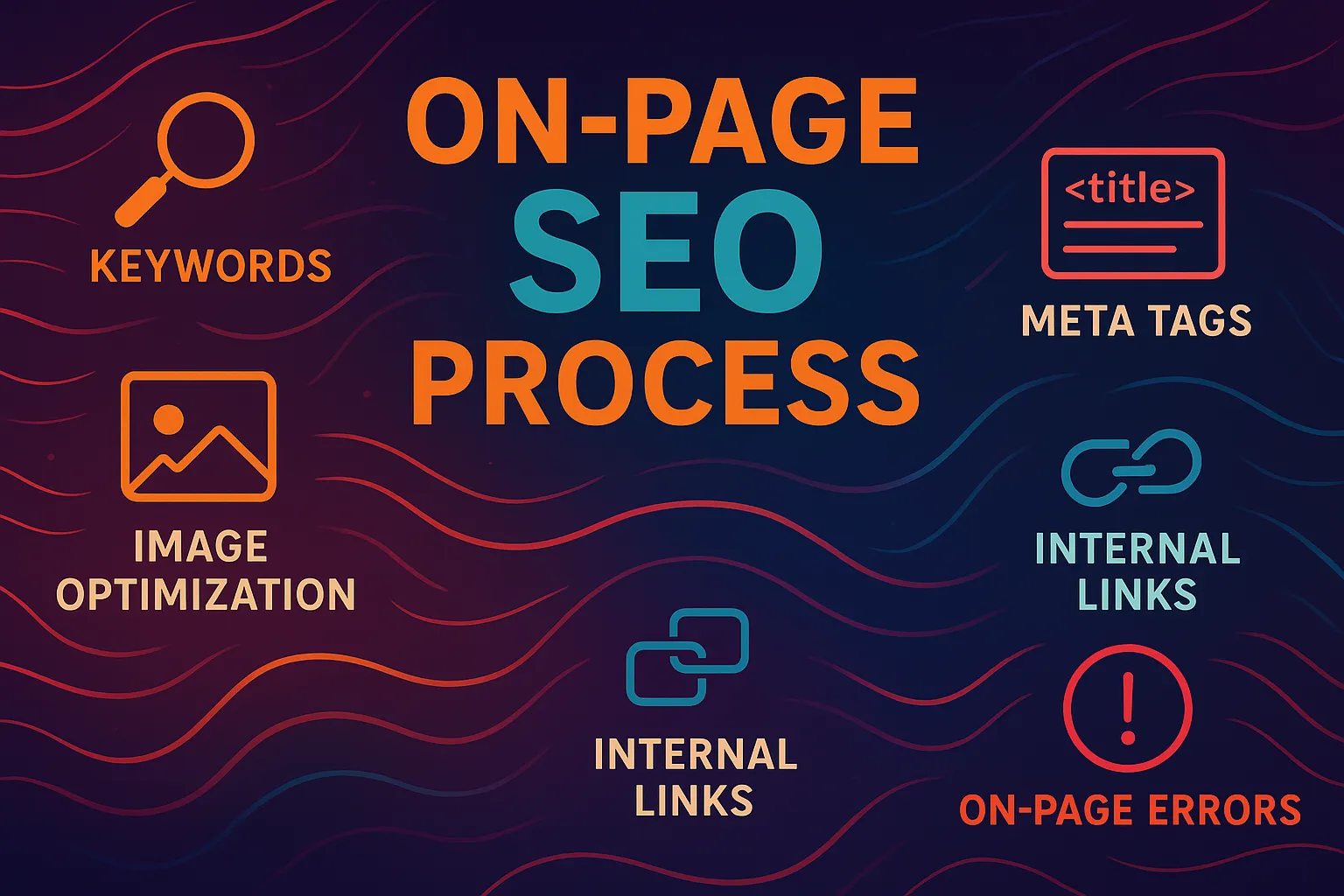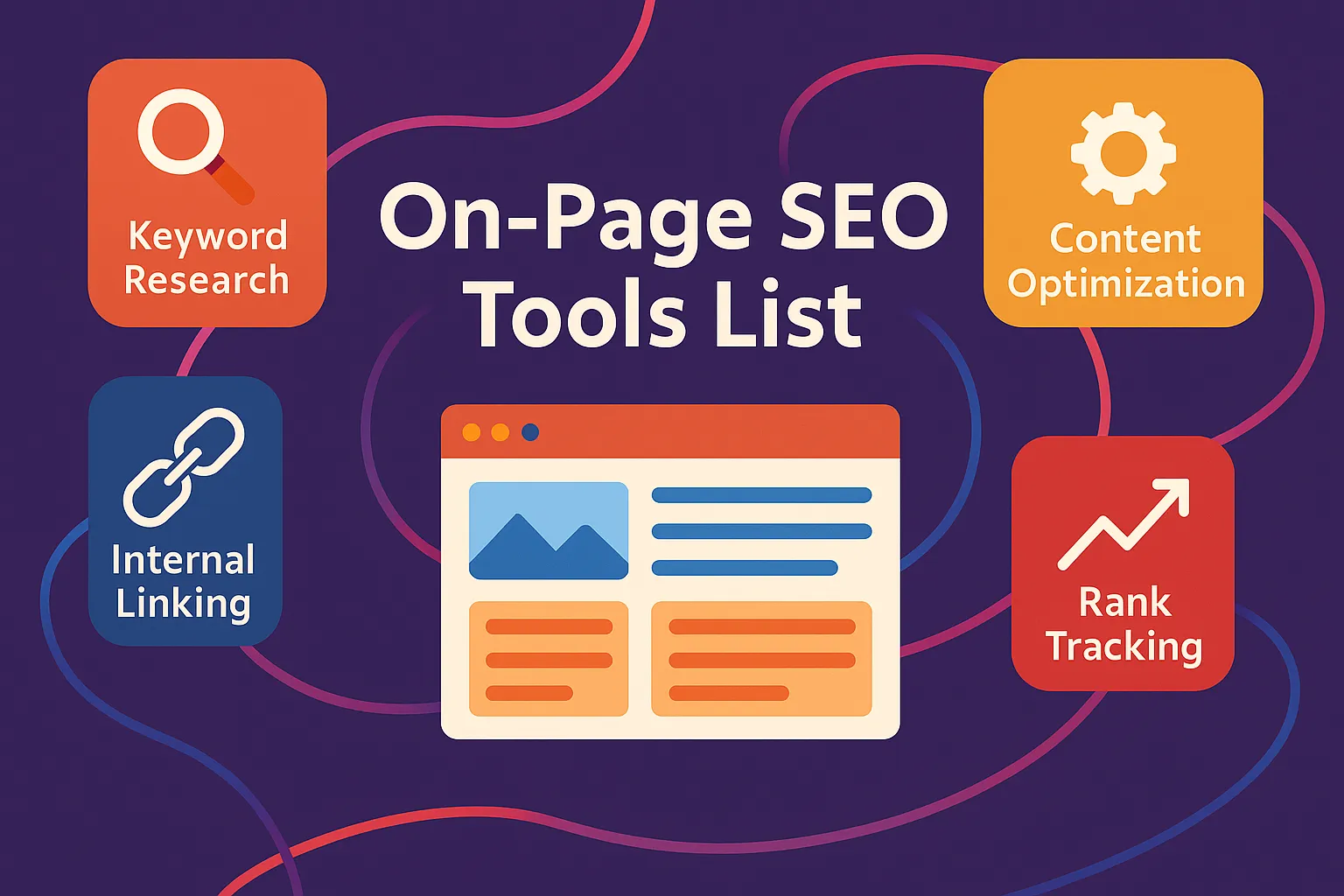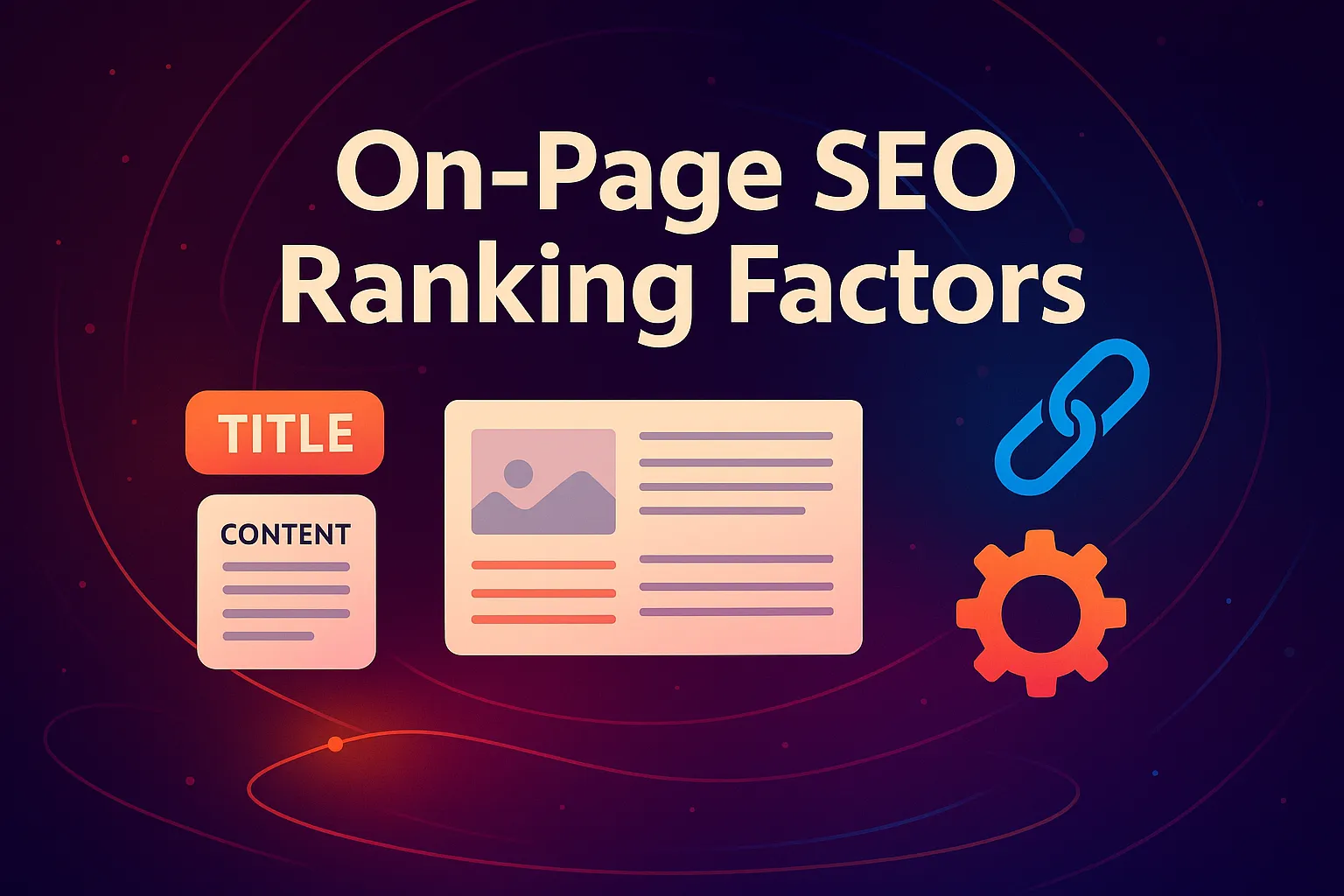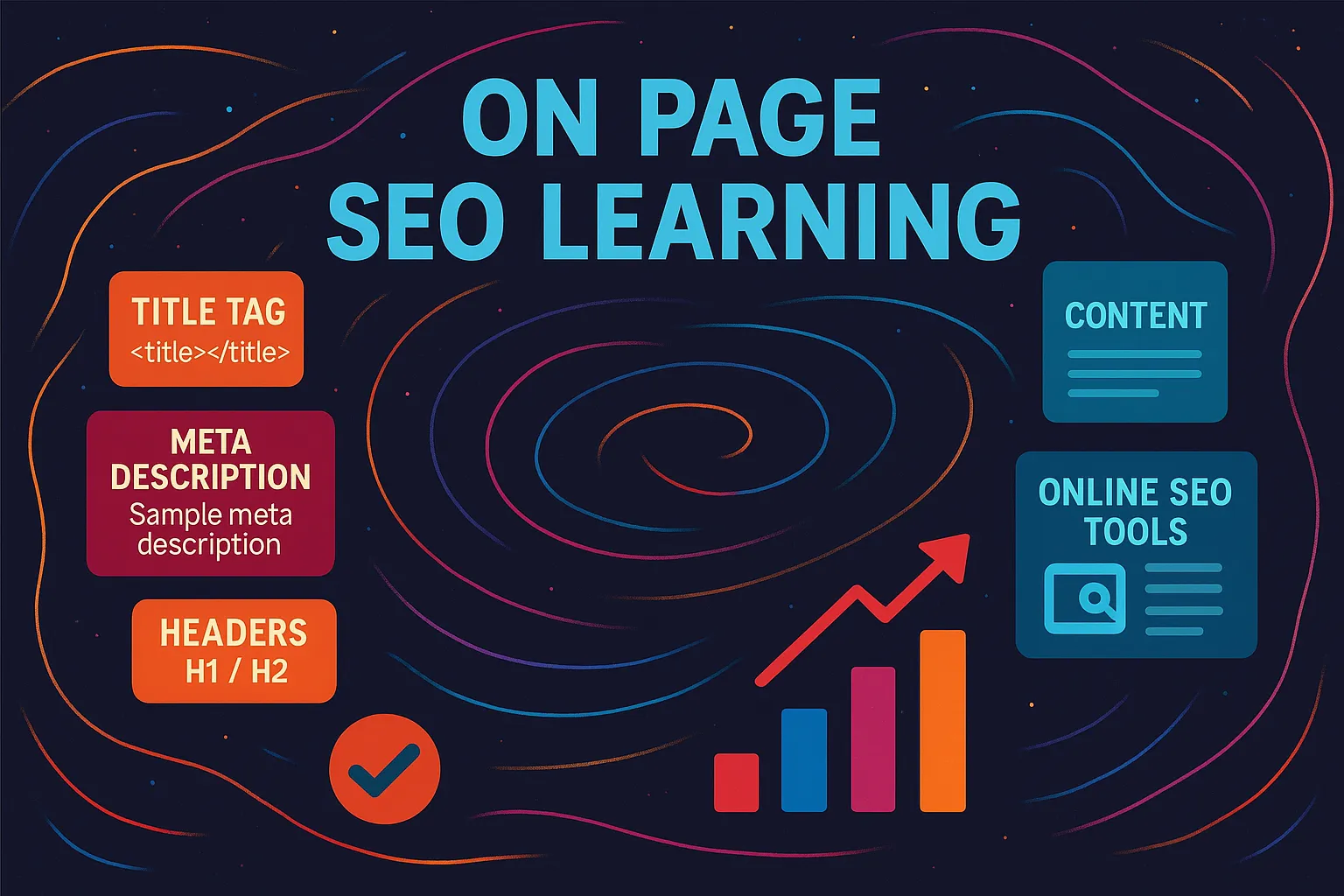What is “on page SEO keyword research”?
On page SEO keyword research is the process of finding the best keywords for a specific page on your website so that it ranks higher in Google search results. Instead of looking at what keywords work across your entire website, you’re focusing on individual pages like your homepage, blog posts, or service pages.
The goal is to choose keywords that match what people are searching for and then place them in the right parts of the page, like the title, headers, and intro paragraph. This helps Google understand what the page is about and whether it should show it to users.
At Vibe Branding, we do this every day. We’ve spent over 10 years helping businesses get seen on Google, and one of the biggest mistakes we see is people skipping this step.
It’s not just about picking a popular keyword; it’s about finding the right one for the right page.
TL;DR (Too Long; Didn’t Read)
- Learn what on page SEO keyword research is and why it matters for your website
- Understand how it differs from general keyword research
- Discover how to pick the right keyword for every page on your site
- Explore free and advanced tools to help with keyword research
- Learn where to place keywords on your page for the best SEO impact
- Get expert insights on how to write naturally and avoid keyword stuffing
- Avoid common mistakes and align your content with Google’s best practices
Why Individual Page Targeting Matters
Every page on your site has a job. Maybe it’s selling a product.
Maybe it’s explaining a service. Or maybe it’s answering a question someone typed into Google. That’s why we believe so strongly in doing on page SEO keyword research for each and every page.
You can’t just sprinkle the same keyword on every page and expect results. At Vibe Branding, we’ve seen how much this targeted approach helps.
One of our clients, a home services business in New York, saw a 47% increase in organic traffic just by making sure each service page had a unique keyword strategy. When your keywords match your page’s purpose, you don’t just rank better—you get more of the right kind of visitors.
You also avoid something called “keyword cannibalization,” which is when multiple pages on your site compete for the same keyword. That confuses Google and weakens your rankings.
Instead, by mapping specific keywords to specific pages, you send a strong, clear signal to search engines.

How to Pick the Right Keyword for Each Page
Choosing the right keyword starts with knowing what the page is supposed to do. Is it a sales page?
Then you want keywords with purchase intent. Is it a blog?
Then go for informational keywords. Here’s what we do at Vibe Branding:
- We brainstorm seed keywords based on the topic of the page.
- We run those through tools like Google Keyword Planner or Moz Keyword Explorer.
- We look for keywords with a mix of good search volume and realistic difficulty.
- We test the keyword on Google to see what kind of content already ranks.
- We match the keyword to the page’s goal.
Let’s say you run a fitness studio. Your homepage shouldn’t be targeting “how to get six-pack abs” because that’s a blog topic.
Instead, it should target something like “fitness studio in Brooklyn” or “personal training gym NYC.” Here’s a quick comparison table of keyword intent:
Keyword | Intent | Best Page Type |
best CRM software | Transactional | Product page |
how to use a CRM | Informational | Blog post |
CRM vs marketing automation | Comparative | Blog post |
CRM software pricing | Commercial | Pricing/service page |
Each of these keywords is useful, but only if it matches the page you’re optimizing.
Tools to Help You With Keyword Research
We use a mix of free and paid tools at Vibe Branding depending on the client’s budget. One thing is clear: no matter your skill level or budget, there’s a tool for you.
Here are our top choices:
- Google Keyword Planner: Free, accurate, best for basic data
- Moz Keyword Explorer: Easy interface, good for volume and difficulty data
- Semrush: Advanced, lots of features including keyword gap and competitive analysis
- WordStream Free Keyword Tool: Good for fast, free insights with location filters
- Ubersuggest: Budget-friendly with useful features for long-tail keywords
Each tool has its strengths. For example, Semrush shows keyword difficulty and current SERP features, while Moz simplifies everything with keyword priority scores.
We always recommend starting with Google Keyword Planner if you’re new to this. Then, as you get more confident, move on to the advanced tools.
How to Judge Keyword Difficulty and Intent
Not every keyword is easy to rank for, and not every keyword is worth your time. That’s why knowing how to judge keyword difficulty and search intent is one of the most important parts of on page SEO keyword research.
Here’s how we evaluate them:
- Search volume: How many people are looking for this each month?
- Difficulty score: Can a small-to-mid site compete?
- Intent: Are users looking to buy, learn, or compare?
- SERP results: What kind of content is ranking right now?
- Opportunities: Is there a featured snippet or image pack we can win?
For instance, the keyword “buy used office chairs” has purchase intent and lower competition than “office furniture.” This means it’s a better fit for a product page targeting conversions.
We always Google our target keyword first. If the results are big brands or national chains, and your site is small and local, you may want to find a longer-tail variation.
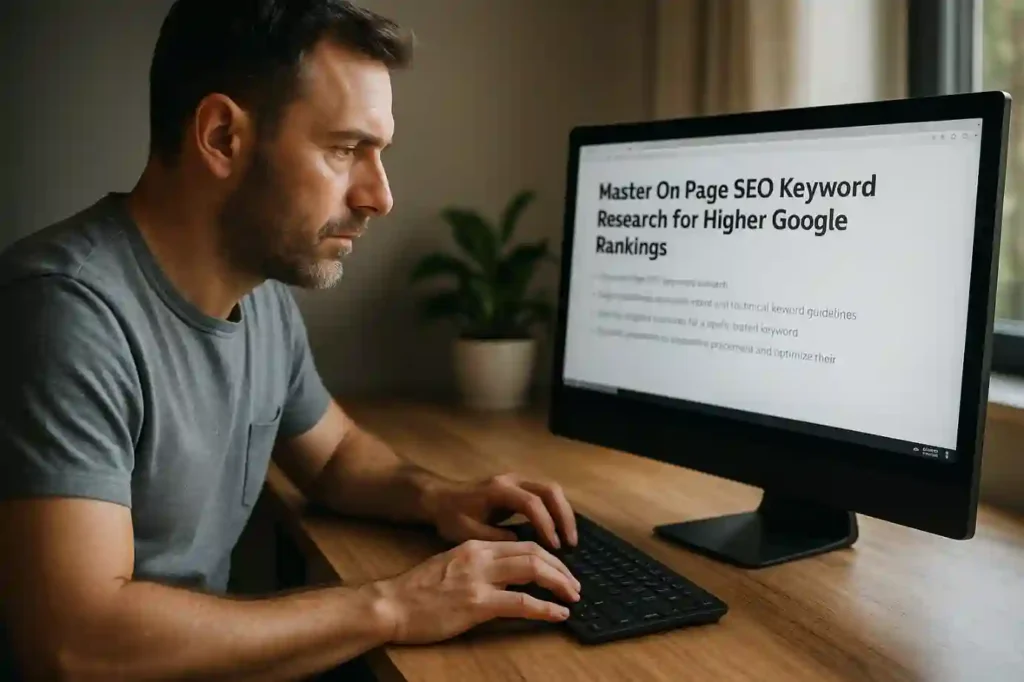
Where to Place Your Keywords on the Page
Placement is just as important as picking the right keyword. Once we finalize our keyword at Vibe Branding, we make sure it’s visible where it counts.
Here’s where we always include the target keyword:
- In the title tag (ideally at the beginning)
- In the URL (simple and keyword-rich)
- In the H1 tag (headline of the page)
- Within the first 100 words of the content
- In at least one H2 or subheading
But we never force it. Keyword stuffing is an old-school tactic that Google penalizes.
Instead, we focus on clean, human-friendly content where keywords appear naturally. The keyword should act like a thread that ties the content together, not a word that shows up in every other sentence.
Using LSI Keywords to Support Your Main Keyword
LSI stands for Latent Semantic Indexing. Sounds fancy, right?
But it’s simple. These are the related terms that Google expects to see when someone writes about a certain topic.
For example, if your keyword is “digital marketing agency,” related terms could be “SEO,” “content strategy,” “Google Ads,” or “branding.” At Vibe Branding, we always include these supporting terms because it shows Google that we’re covering the topic thoroughly.
We use tools like LSIGraph or even the “People Also Ask” section on Google to find them. These keywords usually appear in subheadings, bullet points, or image alt text.
This is also a great way to rank for multiple search terms from one page. Sometimes we’ll even add FAQs with these LSI keywords to cover more ground without writing a whole new post.
How to Write Naturally and Avoid Keyword Stuffing
It’s not 2010. You don’t need to repeat the same phrase 25 times to rank.
In fact, doing that can hurt your SEO. Google wants content that reads well for humans, not just bots.
We use a simple trick at Vibe Branding: write first, optimize second. That means we create the content naturally, and then we go back and check for keyword placement.
If we can insert it smoothly, we do. If it sounds forced, we rewrite the sentence. We also aim for a keyword density of about 1% to 2%.
That’s enough to show relevance without going overboard. We read everything out loud and use tools like Grammarly and Yoast SEO to catch anything that feels robotic.
The best part? Google is smart now. It can understand that “digital branding agency” and “branding company” are related.
So variety isn’t just okay; it’s encouraged.

How Google’s E-E-A-T Impacts Keyword Strategy
E-E-A-T stands for Experience, Expertise, Authoritativeness, and Trustworthiness. Google uses this to decide if your content is worth ranking.
So what does that mean for your keyword strategy? At Vibe Branding, we’ve seen that adding real proof of expertise makes a big difference.
We include author bios, cite sources, and back up claims with data. When we write content about SEO or branding, we pull from real projects and case studies.
This proves we know our stuff. Also, Google wants to know if your site is trustworthy.
So your “About” page, contact info, and content quality all matter. Even your keyword research should reflect this.
For example, we’ll include words like “trusted,” “award-winning,” or “10+ years experience” when they make sense. In the end, your keyword isn’t just about getting seen.
It’s about showing that you deserve to be there.
Common Mistakes to Avoid in On Page SEO Keyword Research
We’ve seen a lot of clients make the same keyword mistakes over the years. One big one is trying to rank every page for the same exact term.
That leads to keyword cannibalization, where Google gets confused about which page to show. Instead, each page needs its own focus keyword.
Another issue is picking high-volume keywords without thinking about intent. Sure, “marketing” might get searched a lot, but what are people actually looking for when they search that?
It’s too vague. You’re better off going for something more specific, like “digital marketing agency for small business.”
People also forget to look at their competitors. If you’re aiming for a term and your competitors all have huge sites with tons of backlinks, it might not be a good fit yet.
Start with something you can win. Then there’s the mistake of not updating keyword research regularly.
Search trends change, and your content should keep up. We recommend reviewing your keywords every quarter.
Finally, don’t ignore long-tail keywords. They’re easier to rank for, bring in more qualified traffic, and are often exactly what your audience is searching for.
Final Thoughts
If you’ve made it this far, you now understand the full scope of how on page SEO keyword research works. It’s more than just plugging words into a tool.
It’s about matching the right intent, placing the keyword smartly, writing content that flows naturally, and proving your authority to both users and search engines. At Vibe Branding, this is how we’ve helped clients for over a decade.
We believe that SEO doesn’t have to be a mystery. When you treat each page like its own opportunity, you turn your site into a lead-generating machine.
So whether you’re optimizing a homepage or writing your next blog, remember—effective keyword research is your compass. Get it right, and the traffic follows.


